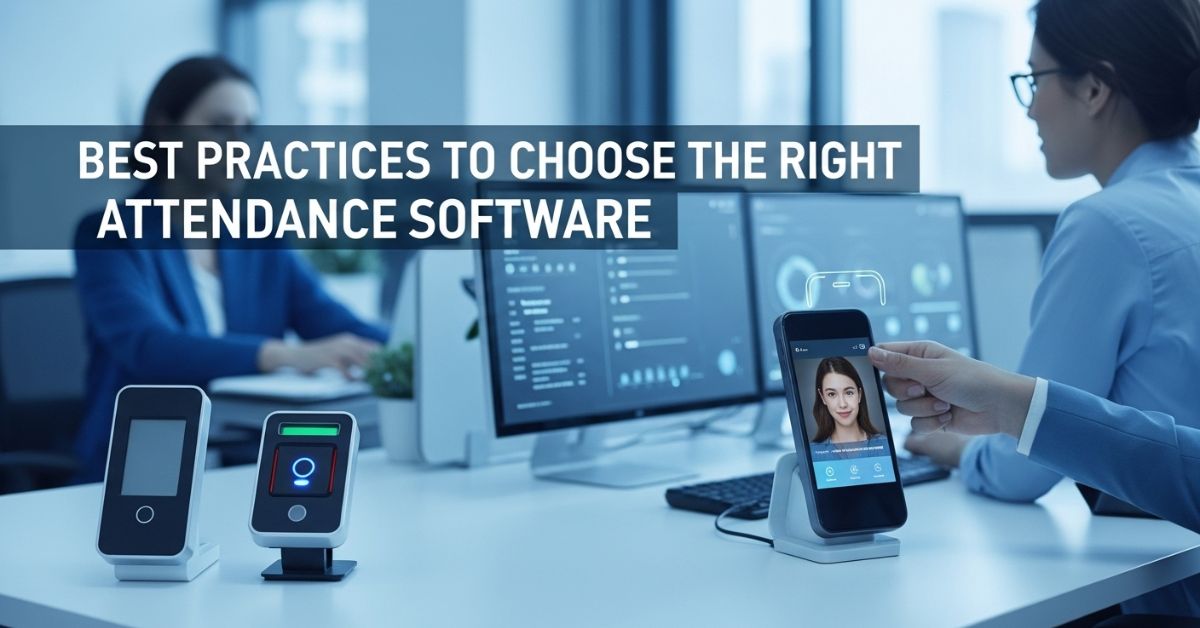Best Practices to Choose the Right Attendance Software

In today’s fast-paced business world, tracking employee time and attendance efficiently is no longer optional—it’s essential. With companies striving to increase productivity, ensure compliance, and reduce manual errors, digital attendance tracking tools have become a necessity. Choosing the best attendance software In India can significantly impact how smoothly your HR and payroll operations function. However, with so many options available, it’s important to follow the right approach to pick a system that suits your company’s size, needs, and goals.
This guide will help you understand what to look for, what to avoid, and how to make the best decision when selecting attendance software for your organization.
1. Identify Your Business Requirements
Before diving into feature comparisons or pricing, start by identifying your company’s unique attendance tracking needs. Consider:
- Number of Employees – Small businesses may only need simple check-in/out tracking, while larger enterprises might require shift scheduling, biometric integration, or mobile access.
- Workforce Type – Do you have remote teams, field workers, or contract employees? The software should accommodate multiple work models.
- Payroll Integration – Does your payroll process depend on accurate attendance records? If yes, seamless integration with payroll systems is a must.
- Compliance Needs – Regional labor laws require strict record-keeping. Choose a platform that complies with Indian statutory regulations.
2. Look for Essential Features
While software platforms vary in complexity, ensure the following core features are included:
- Automated Time Tracking – Manual punching is outdated. Choose a system that automates time entries and flags inconsistencies.
- Leave Management – Built-in leave tracking helps HR avoid overlapping requests or excess approvals.
- Geo-tagging & Biometric Support – Especially useful for remote and on-site workers, these features confirm location-based or biometric authentication.
- Shift Scheduling – For businesses with rotational shifts, the software should allow custom schedule creation.
- Real-time Dashboard & Alerts – A visual overview of late logins, absenteeism, or overtime enhances decision-making.
- Employee Self-Service Portal – Empower employees to check their own records, reducing HR’s workload.
3. Evaluate Integration Capabilities
The software must integrate seamlessly with your existing tools—particularly payroll and HR systems. The top 10 payroll software In India often work best when paired with attendance solutions from the same or compatible providers. This reduces data duplication, simplifies processing, and ensures consistency across all records.
Integration with accounting platforms, ERP software, and cloud storage can also add value, especially for medium to large businesses. Ask the vendor about available APIs or plug-and-play options.
4. Focus on User Experience
A good attendance system should be easy to use—for both HR teams and employees. Key user experience (UX) checkpoints include:
- Mobile Accessibility – Is there a mobile app or web portal for check-ins and updates?
- Multi-language Support – Especially useful for companies with diverse teams across regions.
- Ease of Onboarding – A complicated system can frustrate users. Look for platforms that offer user guides, training, or tutorials.
- Customizable Reports – Ensure you can generate custom reports for attendance, leave trends, or compliance audits.
5. Cloud vs On-Premise: Make the Right Choice
Indian businesses are increasingly moving towards cloud-based attendance solutions because of their flexibility, scalability, and real-time capabilities. Unlike traditional on-premise systems, cloud platforms offer:
- Automatic Updates
- Remote Access
- Lower Setup Costs
- Data Backup & Security
Choosing cloud-based tools helps you stay agile and adaptable, especially if your workforce is hybrid or remote. Most Top HR Companies in India prefer cloud solutions due to their performance and long-term ROI.
6. Security and Data Privacy
Attendance systems hold sensitive employee information—make sure the platform is secure. Key elements to check include:
- Data Encryption
- Role-Based Access
- Audit Logs
- Two-Factor Authentication
Also, check if the software provider complies with India’s data privacy guidelines and has disaster recovery protocols in place.
7. Cost vs Value: Don’t Just Go for the Cheapest
While it’s tempting to choose the most affordable option, remember that software is an investment. A cheaper platform might lack essential features or have limited support. Consider:
- Subscription Model – Monthly, yearly, or one-time payment?
- Hidden Costs – Setup, training, customizations, or integration fees?
- Scalability – Will the software grow with your company?
Compare a few shortlisted platforms, ask for demos, and calculate ROI before finalizing.
8. Vendor Support & Reputation
No matter how powerful a software is, without reliable support, it’s not worth the risk. Look for vendors who:
- Offer 24/7 or prompt customer support
- Have a proven track record
- Provide documentation or training
- Have transparent pricing and clear SLA (Service Level Agreements)
Check reviews, case studies, or user testimonials before making a choice. You can also ask the vendor to connect you with existing customers for feedback.
9. Run a Trial or Pilot
Before committing long-term, request a free trial or a short-term pilot program. This helps:
- Evaluate real-time performance
- Test compatibility with your HR and payroll systems
- Gather feedback from your team
- Identify any learning curve or bugs
A well-structured trial can give you clarity on whether the software fits your operations.
10. Review Analytics & Insights Capabilities
Modern attendance software should offer actionable insights, not just raw data. Analytics dashboards can help identify:
- Employees with frequent absences
- Departments with low productivity
- Peak working hours
- Overtime trends
These reports support better planning, workforce optimization, and performance reviews.
Final Thoughts
Choosing the right attendance software isn’t just about digitizing punch-ins and outs—it’s about improving workforce efficiency, boosting transparency, and aligning attendance data with your business goals. By following these best practices, you can ensure your investment adds real value and simplifies your HR operations.
As companies aim for smarter workforce management, tools that unify HR, payroll, and attendance functions are becoming more essential. Many of the top Hr Companies In India rely on integrated attendance solutions to drive accuracy, engagement, and compliance.
Make the smart move—research, compare, test, and invest in a system that truly fits your team and culture.



